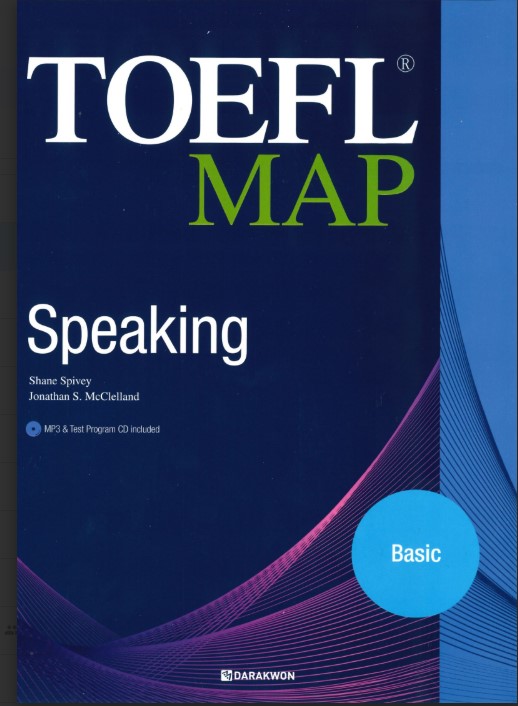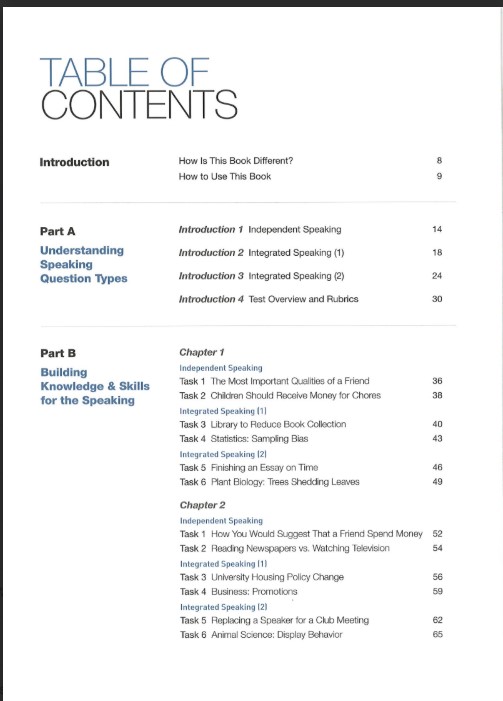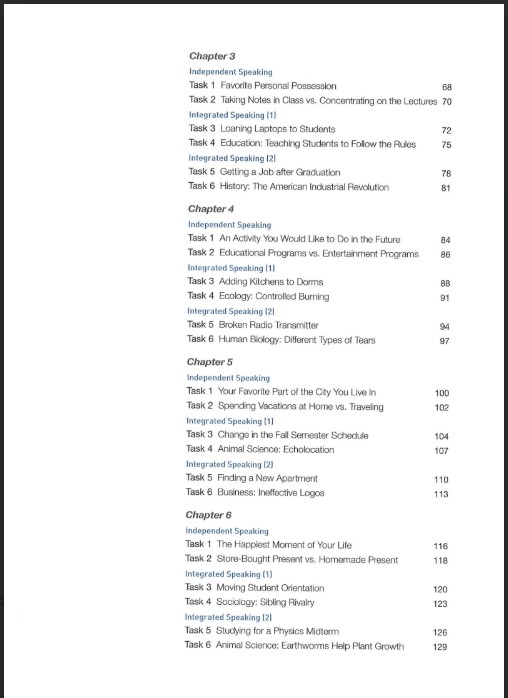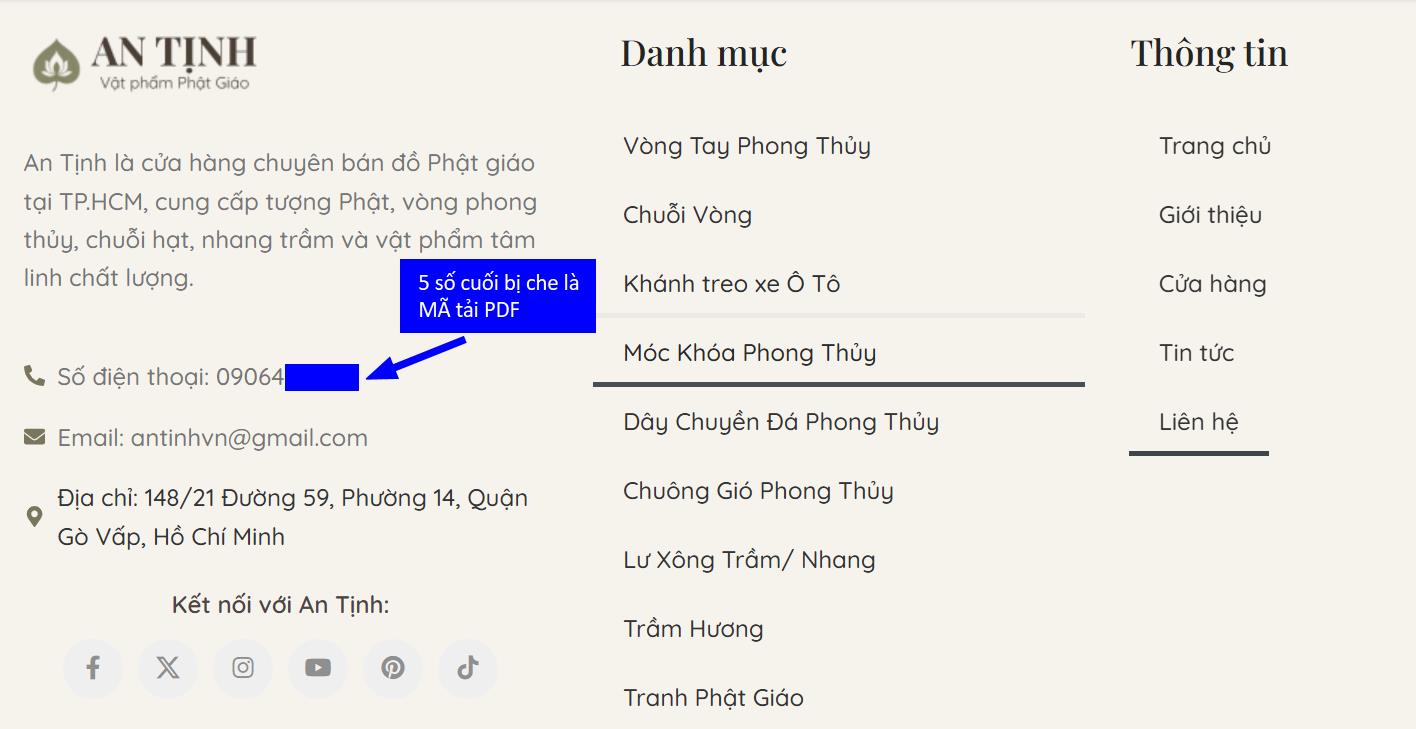


Image 1: Table of Contents – Page 1
TABLE OF CONTENTS
Introduction
How Is This Book Different? 8
How to Use This Book 9
Part A
Understanding Speaking Question Types
Introduction 1 Independent Speaking 14
Introduction 2 Integrated Speaking (1) 18
Introduction 3 Integrated Speaking (2) 24
Introduction 4 Test Overview and Rubrics 30
Part B
Building Knowledge & Skills for the Speaking
Chapter 1
Independent Speaking
Task 1 The Most Important Qualities of a Friend 36
Task 2 Children Should Receive Money for Chores 38
Integrated Speaking (1)
Task 3 Library to Reduce Book Collection 40
Task 4 Statistics: Sampling Bias 43
Integrated Speaking (2)
Task 5 Finishing an Essay on Time 46
Task 6 Plant Biology: Trees Shedding Leaves 49
Image 2: Table of Contents – Page 2
Chapter 2
Independent Speaking
Task 1 How You Would Suggest That a Friend Spend Money 52
Task 2 Reading Newspapers vs. Watching Television 54
Integrated Speaking (1)
Task 3 University Housing Policy Change 56
Task 4 Business: Promotions 59
Integrated Speaking (2)
Task 5 Replacing a Speaker for a Club Meeting 62
Task 6 Animal Science: Display Behavior 65
Chapter 3
Independent Speaking
Task 1 Favorite Personal Possession 68
Task 2 Taking Notes in Class vs. Concentrating on the Lectures 70
Integrated Speaking (1)
Task 3 Loaning Laptops to Students 72
Task 4 Education: Teaching Students to Follow the Rules 75
Integrated Speaking (2)
Task 5 Getting a Job after Graduation 78
Task 6 History: The American Industrial Revolution 81
Chapter 4
Independent Speaking
Task 1 An Activity You Would Like to Do in the Future 84
Task 2 Educational Programs vs. Entertainment Programs 86
Integrated Speaking (1)
Task 3 Adding Kitchens to Dorms 88
Task 4 Ecology: Controlled Burning 91
Integrated Speaking (2)
Task 5 Broken Radio Transmitter 94
Task 6 Human Biology: Different Types of Tears 97
Chapter 5
Independent Speaking
Task 1 Your Favorite Part of the City You Live in 100
Task 2 Spending Vacations at Home vs. Traveling 102
Integrated Speaking (1)
Task 3 Change in the Fall Semester Schedule 104
Task 4 Animal Science: Echolocation 107
Integrated Speaking (2)
Task 5 Finding a New Apartment 110
Task 6 Business: Ineffective Logos 113
Chapter 6
Independent Speaking
Task 1 The Happiest Moment of Your Life 116
Task 2 Store-Bought Present vs. Homemade Present 118
Integrated Speaking (1)
Task 3 Moving Student Orientation 120
Task 4 Sociology: Sibling Rivalry 123
Integrated Speaking (2)
Task 5 Studying for a Physics Midterm 126
Task 6 Animal Science: Earthworms Help Plant Growth 129
Image 3: Table of Contents – Page 3
Chapter 7
Independent Speaking
Task 1 Favorite Place to Study 132
Task 2 Students Should Have Part-Time Job Experience 134
Integrated Speaking (1)
Task 3 Fitness Center Renovation 136
Task 4 Business: Giving Samples 139
Integrated Speaking (2)
Task 5 Rude Roommate 142
Task 6 Plant Biology: Root Adaptations 145
Chapter 8
Independent Speaking
Task 1 Advice for a Child Starting School 148
Task 2 Same Weather vs. Changing Weather 150
Integrated Speaking (1)
Task 3 Spring Concert Series 152
Task 4 Psychology: Mental Accounting 155
Integrated Speaking (2)
Task 5 Planning a Picnic 158
Task 6 Animal Science: Electric Fish 161
Part C
Experiencing the TOEFL® iBT Actual Tests
Actual Test 1
Independent Speaking 166
Integrated Speaking (1) 168
Integrated Speaking (2) 172
Actual Test 2
Independent Speaking 178
Integrated Speaking (1) 180
Integrated Speaking (2) 184
Image 4: Introduction 1 – Independent Speaking – Page 1
Introduction 1
Independent Speaking
Task 1 Independent Speaking – Open Choice
Task Overview
This question asks the student to give an answer based on his or her own feelings, thoughts, or opinions. Test takers should focus on quickly thinking of an answer. The answer needs to respond narrowly to the question. In TOEFL® Map Speaking Basic, the question will appear printed in the book. However, on the actual test, the topic will also be read to the student by a narrator.
How It Appears
What advice would you give a friend who is afraid to talk in front of groups? Use details, reasons, and examples to support your explanation.Describe the most enjoyable vacation you have ever taken. Include details and examples to support your explanation.What are the most important qualities for good parents to have? Use details and examples to support your explanation.
Tips for Success
■ Remember that this question type does not have right or wrong answers. Your response does not need to be honest, so you can use reasons or examples even if they are not true. Choose an answer quickly and explain it with details, examples, and reasons.
■ This task grades a student’s ability to speak clearly. Be sure to speak slowly and to focus on your pronunciation.
■ Use clear transitions from your introduction and to each point.
Image 5: Introduction 1 – Independent Speaking – Page 2
Example of the Task
Question
If you could live anywhere in the world, where would you want to live? Include details and examples to support your explanation.
Preparation time: 15 seconds | Response time: 45 seconds
Sample Response
[Introduction] Out of all the places in the world to live, I would most want to live in New York City.
[Detail] New York City is one of the largest cities in the world. It has thousands of restaurants, theatres, and places of interest.
[Example] Living in New York City would allow me to do something exciting every day. One day I could see a Broadway performance. The next day, I could watch a baseball game at Yankee Stadium. I could even meet celebrities at an expensive restaurant.
Explanation
A good response to the first task should fully respond to the prompt. In this case, the prompt asks the student to explain where he or she would want to live. The test taker is also asked to give an example. The response begins by answering where the test taker would want to live (New York City). This is followed by a general description of New York City and why it is interesting. The response concludes with examples of activities the speaker could do by living in New York City.


